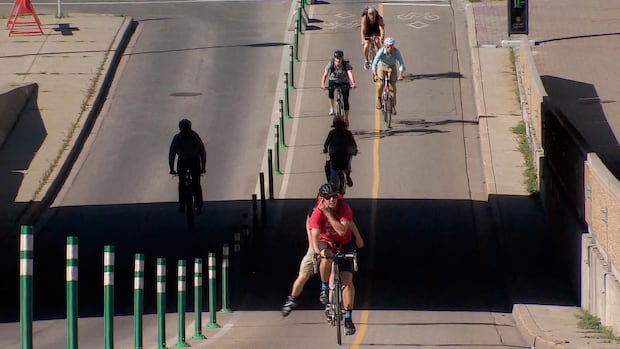Alberta monitoring debate over bike lanes in Ontario, considering similar legislation
Province considering similar policy despite court striking down part of Ontario's plan

Alberta's transportation minister said the province is monitoring how a debate plays out in Ontario over a bill that would remove three Toronto bike lanes, while considering similar legislation in Alberta.
On Wednesday, an Ontario court deemed that the province's plan to remove 19 kilometres of protected bike lanes in Toronto was unconstitutional, because it would "put people at increased risk of harm and death."
Ontario's transportation minister said the province will appeal the decision.
Devin Dreeshen, Alberta's minister of transportation and economic corridors, said on Wednesday his government will watch how the appeal plays out closely, after previously noting the province is "actively reviewing" bike lanes in Calgary and Edmonton that draw complaints from residents.
"We're obviously looking to see how that legislation plays out in Ontario, and the possibility of introducing a similar type of legislation here in Alberta," said Dreeshen.
The transportation minister said he supports cities expanding bike routes without "cannibalizing" driving lanes engineered for cars, and increasing daily commute times for drivers. He added Alberta can learn from what worked and didn't work in Ontario's legislation, when crafting its own policy.
Dreeshen specifically pointed to bike lanes at Ninth Avenue and Fourth Street S.E., at the intersection near the National Music Centre, as a problem area in Calgary the province is looking at.
Calgary says it currently has roughly 290 kilometres, in total, of "on-street bikeways and cycle tracks." Cycle tracks are protected from traffic by physical barriers or an elevation difference from the road. Bikeways include a variety of "on-street routes," including painted bike lanes dedicated to cyclists and streets with a "shared lane" designation but no dedicated spaces for cyclists.

City council approved $56 million for Calgary's network of pathways and bikeways in 2023, and its long-term transportation plan looks to expand the network more throughout the next 60 years, including several ongoing projects.
Earlier on Wednesday, Dreeshen met with Calgary Mayor Jyoti Gondek at city hall to discuss the issue. It's part of an overall effort, he said, to gather information from Alberta's major cities on bike lanes before potentially presenting new legislation.
"Hopefully, both Edmonton and Calgary can look at some really problematic bike lane expansions and cancel them, but we'll see how the conversation goes in the next couple months," said Dreeshen.
He said the province will ask the same questions in Edmonton to understand its cycling network as well. But on Wednesday, the City of Edmonton said Mayor Amarjeet Sohi hasn't received a request from Dreeshen to meet and discuss bike lanes.
In April, Dreeshen voiced opposition to Edmonton's planned bike-lane expansions, and said the province won't support "tax dollars being used to reduce road capacity."
Wednesday's court decision in Ontario came as its provincial government pushes to remove bike lanes as a solution to Toronto's traffic congestion, while cyclists and advocates have argued the infrastructure is crucial for public safety. Justice Paul Schabas concluded that removing bike lanes will not reduce traffic buildup, highlighting expert evidence that bike lanes do the opposite by providing an alternative mode of transportation.
Bike lanes account for less than 1% of Calgary's roads: mayor
After meeting with Dreeshen, Calgary's mayor said their meeting was a positive one where the city and province agreed to work together on how best to accommodate all modes of transportation.
"Today was not a meeting of contradictions, it was one of collaboration," said Gondek.
Calgary's pathways network keeps cyclists safe and separated from traffic, Gondek said, while adding that bike lanes account for less than one per cent of the city's road surfaces and are designed for minimal disruption.
She also noted Calgary's bike lane infrastructure is movable, and the city regularly reviews bike lanes, like any other transportation infrastructure, based on public feedback.
"These bike lanes are not fixed. If a bike lane is causing any concerns with congestion or parking, our traffic team is open to reviewing and making any necessary changes," said Gondek.
Dreeshen said he was pleasantly surprised to hear Gondek has the view that bike lanes are temporary. He further said the build-up of bike lanes in Calgary and Edmonton affects nearly all commuters in those cities.
"If you have a municipal council that is taking away driving lanes that's actually increasing people's daily commutes, or emergency vehicles or delivery vehicles from being able to just do what they do, that's obviously a problem," said Dreeshen.
Francisco Alaniz Uribe, an associate professor at the University of Calgary's school of architecture, planning and landscape, said historically, transportation regulation is based on safety and improving the number of ways people can access their streets, and that it doesn't make technical sense to remove safe ways for cyclists to use the city's roads.
"We know that when you make biking infrastructure more safe, people use it more," said Alaniz Uribe.
"The main objective of the discussion should be about safety, it should be about [affordability], and bike lanes do that. They make the space safer for everyone, for pedestrians, for cycling, even for drivers."
Converting on-street parking into separated bike lanes creates a safe way for more people to get around the city, Alaniz Uribe argued, while also making commutes easier for people who can't afford a car during a time when vehicles are getting more expensive.
"It provides a lot more benefits than what it takes away for some people and their cars," said Alaniz Uribe.
With files from Bryan Labby and Kelsea Arnett


